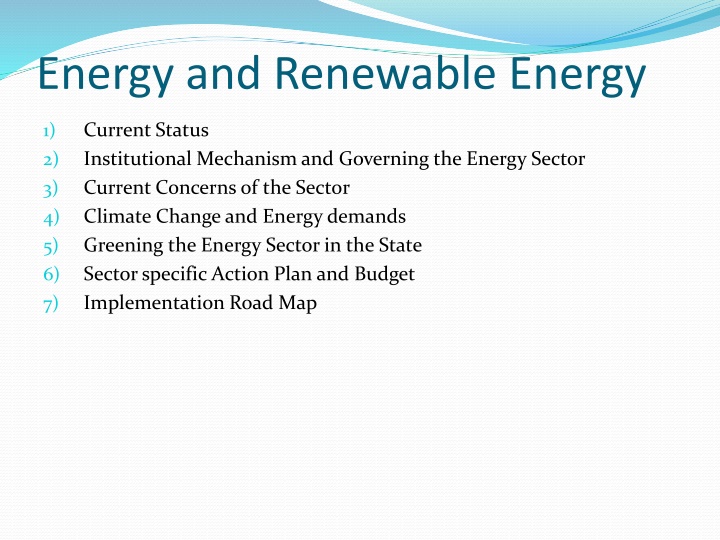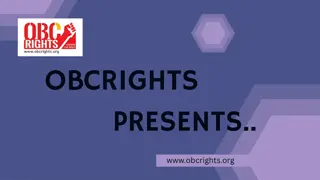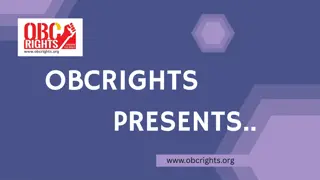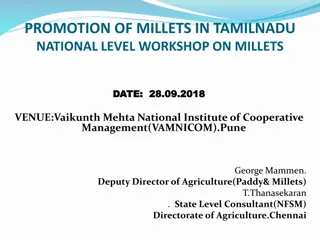Renewable Energy Status and Trends in Tamil Nadu: Challenges and Opportunities
Renewable energy accounts for a significant portion of Tamil Nadu's electricity grid capacity, with a focus on wind energy. Despite this, the actual energy generated from renewable sources remains low. The state faces challenges such as high electricity consumption, sector-wise variations, and transmission and distribution losses. Efforts towards rural electrification have been successful, but there is a need to align future projections with renewable energy targets to meet growing energy demands.
Download Presentation

Please find below an Image/Link to download the presentation.
The content on the website is provided AS IS for your information and personal use only. It may not be sold, licensed, or shared on other websites without obtaining consent from the author.If you encounter any issues during the download, it is possible that the publisher has removed the file from their server.
You are allowed to download the files provided on this website for personal or commercial use, subject to the condition that they are used lawfully. All files are the property of their respective owners.
The content on the website is provided AS IS for your information and personal use only. It may not be sold, licensed, or shared on other websites without obtaining consent from the author.
E N D
Presentation Transcript
Energy and Renewable Energy Current Status Institutional Mechanism and Governing the Energy Sector Current Concerns of the Sector Climate Change and Energy demands Greening the Energy Sector in the State Sector specific Action Plan and Budget Implementation Road Map 1) 2) 3) 4) 5) 6) 7)
Energy and Renewable Energy Current Status Sector status and growth Renewable energy sector accounts to close to 40 percent of the Tamil Nadu Electricity Board s Grid Capacity. An average of 55-60 percent of the power requirement of state is purchased Even with large installation capacity from renewable energy sources the actual energy generated is fairly low. Thermal generation contributes fairly significantly to the electricity requirement of the state. Plant load factor of wind farms is between 12.56-22percent The average deficit power of the state is roughly 6.5 percent or approximately 5000 Million Units per year 1)
Energy and Renewable Energy Electricity Consumption Pattern High electricity consumption of about 1065kWh Highest number are the domestic consumers Steady rise in domestic consumption, commercial sector consumption has remained static Decrease in agricultural sector power consumption Steady rise in the consumption in the industrial sector Transmission and Distribution Loss Loss due to T&D is fairly low. About 18.23 percent. Addition of 1509 CTK.KM of High Tension Lines in 2008 has also resulted in a drop in the Transmission and distribution losses. Due to excessive congestion of the Southern Electricity grid the amount of electricity that the grid can transfer cannot be further increased.
Energy and Renewable Energy Renewable energy trends Increased renewable energy capacity over the years 34 percent of India s renewable energy space Wind energy most successful Rural Electrification 100 percent rural electrification Census 2011 state that 93 percent of the total households in the state have access to electricity Other Electricity usage 2001 census of house hold consumption showed-13 percent use kerosene; 64.3 percent of the household continue to use firewood; 19 percent of the households use CNG. Expected Projections Year Total Electricity demand Total production for renewable sources 2017 55,000MW 18,000MW 2022 70,000MW 34,000MW
Energy and Renewable Energy Energy Efficiency and Conservation Replacement of incandescent bulbs with CFLs / Fluorescent Tube Lights in all Government offices as well as in hutments All Electrical equipment to comply with BEE efficiency standards Aiming to promote energy efficient appliances for domestic use Agricultural sector demand side financing Other technical committee to adopt and evolve guidelines for building planning authorities Ensure inter-departmental co ordination and monitoring in various schemes
Energy and Renewable Energy Institutional Mechanism and Governing the Energy Sector The Tamil Nadu Electricity Board(TNEB) Ltd. is regulated by the Tamil Nadu Electricity Regulatory Commission (TNERC). Policies and guidelines for power sector development are framed by the Department of Energy and Government of Tamil Nadu Electrical safety and energy conservation-Electrical Inspectorate Department, Tamil Nadu Renewable energy development in the state-Energy Development Agency (TEDA)
Energy and Renewable Energy Current Concerns of the Sector Increased level of industrialization hence, need to greater energy supply Financial implications of tapping renewable energy Shortage of increased demand Aggregate Technical and Commercial loss static Need to implement energy efficiency and conservation Climate change impacts Increased demand of energy due to temperature rise Dependence of farmers on ground water due to scanty and sporadic rainfall Rapid rate of growth in urban areas increases demand
Energy and Renewable Energy Climate Change and Energy demands Energy Consumption and Heat Island Effect - it is estimated that there would be approximately a 14-15 percent increase in electricity consumption in the state due to temperature rise, growth of domestic consumers, increase in consumption due to growth in GDP, increase in electricity coverage area Water and hydropower generation- the state is dependent on Hydropower for electricity production, with science based evidence that river systems in India could possibly be affected due to Climate Change, the shortfall in electricity supply could intensify further.
Energy and Renewable Energy Forests and Fuelwood use-2001 census showed that 64 percent of the total households in the state were still using firewood as the predominant fuel for cooking and heating purposes Irrigation and electricity use- Increased reliance on ground water, due to lack of surface water, for irrigation purposes has led to rise in demand for electricity in the agriculture sector
Energy and Renewable Energy Greening the Energy Sector in the State Renewable energy development plans Development of a road map for promotion of solar power generation systems Integrating biomass based power projects with energy plantations in coordination with the Forest Department Levying Green Energy cess to fund renewable energy development Encouraging private public partnership in renewable energy projects and incentivizing renewable energy investments in the state Enhanced Energy Conservation Initiating Pilot studies for energy conservation and demand side management improvements and strengthening Demonstration Projects Awareness generation and Capacity building
Energy and Renewable Energy Compliance of Energy Conservation policies in all Government and public buildings of Tamil Nadu Other areas would include adopting a waste heat recovery policy for the industrial sector Reducing A T &C losses To ensure the reduction of A T & C Losses from the current level of 18 percent to 15 percent by 2017 with an attempt to furhter bring it down to 12 percent in the future
Energy and Renewable Energy Strategies Minimize AT & C Losses Undertake efficiency and energy conservation improvements Launch Green Villages and introduce Energy Efficient Homes Initiative Drafting new building bye-laws incorporating principles of Energy Conservation and building code Increasing grid connected RE by 10,650 MW Encourage Off Grid Renewable Energy development























